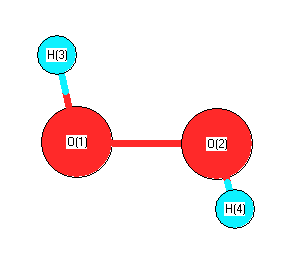Jump to
S1C2
Energy calculated at QCISD(T)=FULL/cc-pVTZ
| | hartrees |
|---|
| Energy at 0K | -151.384879 |
| Energy at 298.15K | -151.387157 |
| HF Energy | -150.835793 |
| Nuclear repulsion energy | 36.828127 |
The energy at 298.15K was derived from the energy at 0K
and an integrated heat capacity that used the calculated vibrational frequencies.
Vibrational Frequencies calculated at QCISD(T)=FULL/cc-pVTZ
| Mode Number |
Symmetry |
Frequency
(cm-1) |
Scaled Frequency
(cm-1) |
IR Intensities
(km mol-1) |
Raman Act
(Å4/u) |
Dep P |
Dep U |
|---|
| 1 |
A |
3822 |
3658 |
|
|
|
|
| 2 |
A |
1440 |
1378 |
|
|
|
|
| 3 |
A |
914 |
875 |
|
|
|
|
| 4 |
A |
366 |
351 |
|
|
|
|
| 5 |
B |
3821 |
3657 |
|
|
|
|
| 6 |
B |
1329 |
1272 |
|
|
|
|
Unscaled Zero Point Vibrational Energy (zpe) 5846.7 cm
-1
Scaled (by 0.9569) Zero Point Vibrational Energy (zpe) 5594.7 cm
-1
See section
III.C.1 List or set vibrational scaling factors
to change the scale factors used here.
See section
III.C.2
Calculate a vibrational scaling factor for a given set of molecules
to determine the least squares best scaling factor.
Geometric Data calculated at QCISD(T)=FULL/cc-pVTZ
Point Group is C2
Cartesians (Å)
| Atom |
x (Å) |
y (Å) |
z (Å) |
|---|
| O1 |
0.000 |
0.727 |
-0.058 |
| O2 |
0.000 |
-0.727 |
-0.058 |
| H3 |
0.795 |
0.888 |
0.461 |
| H4 |
-0.795 |
-0.888 |
0.461 |
Atom - Atom Distances (Å)
| |
O1 |
O2 |
H3 |
H4 |
| O1 | | 1.4541 | 0.9627 | 1.8731 |
O2 | 1.4541 | | 1.8731 | 0.9627 | H3 | 0.9627 | 1.8731 | | 2.3832 | H4 | 1.8731 | 0.9627 | 2.3832 | |
 More geometry information
More geometry information
Calculated Bond Angles
| atom1 |
atom2 |
atom3 |
angle |
|
atom1 |
atom2 |
atom3 |
angle |
| O1 |
O2 |
H4 |
99.606 |
|
O2 |
O1 |
H3 |
99.606 |
Electronic energy levels
Charges, Dipole, Quadrupole and Polarizability
Jump to
S1C1
Energy calculated at QCISD(T)=FULL/cc-pVTZ
| | hartrees |
|---|
| Energy at 0K | -151.383197 |
| Energy at 298.15K | |
| HF Energy | -150.833763 |
| Nuclear repulsion energy | 36.676146 |
The energy at 298.15K was derived from the energy at 0K
and an integrated heat capacity that used the calculated vibrational frequencies.
Vibrational Frequencies calculated at QCISD(T)=FULL/cc-pVTZ
| Mode Number |
Symmetry |
Frequency
(cm-1) |
Scaled Frequency
(cm-1) |
IR Intensities
(km mol-1) |
Raman Act
(Å4/u) |
Dep P |
Dep U |
|---|
| 1 |
Ag |
3850 |
3684 |
|
|
|
|
| 2 |
Ag |
1533 |
1467 |
|
|
|
|
| 3 |
Ag |
911 |
871 |
|
|
|
|
| 4 |
Au |
312i |
298i |
|
|
|
|
| 5 |
Bu |
3856 |
3690 |
|
|
|
|
| 6 |
Bu |
1246 |
1192 |
|
|
|
|
Unscaled Zero Point Vibrational Energy (zpe) 5542.1 cm
-1
Scaled (by 0.9569) Zero Point Vibrational Energy (zpe) 5303.2 cm
-1
See section
III.C.1 List or set vibrational scaling factors
to change the scale factors used here.
See section
III.C.2
Calculate a vibrational scaling factor for a given set of molecules
to determine the least squares best scaling factor.
Geometric Data calculated at QCISD(T)=FULL/cc-pVTZ
Point Group is C2h
Electronic energy levels
Charges, Dipole, Quadrupole and Polarizability
